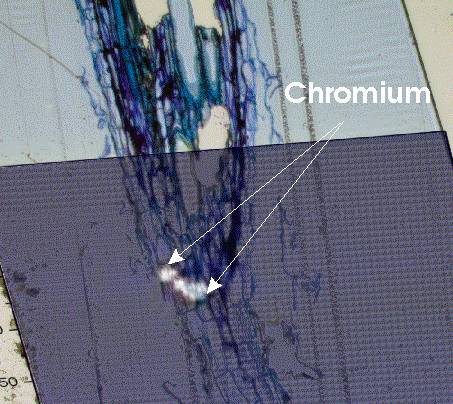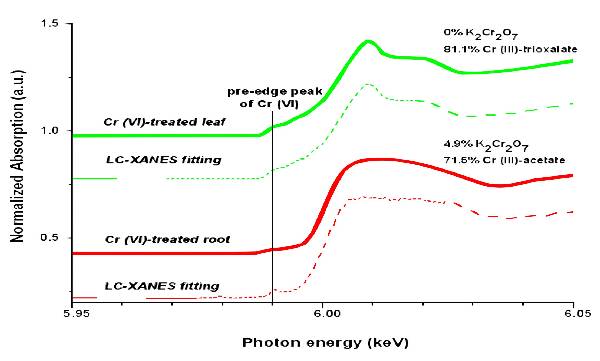
X-ray microprobe of Cr (III) treated root of B. juncea.
Behavior of Chromium in the Rhizosphere of Brassica juncea (Indian Mustard)
S. Bluskov1*, J. M. Arocena1, J. P. Young1, and O.O. Omotoso2 1University of Northern BC, Prince George, BC, Canada V2N 4Z9 2Natural Resources Canada, CANMET Energy Technology Centre, Devon, AB, Canada T9G 1A8 *bluskovs@unbc.ca
Introduction
Chromium is a unique metal, because it exists in soil environments in two stable valence states with differing charge, solubility, mobility, and toxicity. While Cr (III) is present in most soils as relatively immobile, insoluble, and non-toxic oxides and hydroxides, Cr (VI) is present as highly soluble and relatively toxic chromate and dichromate. The main concern about soil chromium is associated with the mobility of Cr (VI) compounds that can easily leach into groundwater or accumulate in vegetation, thereby causing risks to humans and animals. Moreover, the relatively harmless Cr (III) could also be a concern if, under certain soil conditions, it is converted to the hazardous Cr (VI).
In phytoremediation, special plant species can extract (phytoextraction) and transform (phytostabilization) toxic metals into non-toxic, immobile chemical compounds. In order to properly evaluate the risk posed by chromium-contaminated soils, it is essential to understand mechanism(s) involved in the metal binding and sequestration by plants. The rhizosphere zone is of particular interest, because it serves as the main entry point of metals into plant roots.
The objectives of this study were: (i) to investigate the effect of Cr (III vs VI) and soil (field-moist vs air-dried) treatments on solubility and, hence, availability of chromium; (ii) to assess speciation of chromium in polluted rhizosphere and bulk soils; (iii) to determine to which extent B. juncea can absorb chromium ; (iv) to identify the form of accumulated and translocated chromium, its chemical speciation and distribution within the plant.
Some Aspects Examined
- Chromium speciation in soils
- Solubility of Chromium in soils
- Chrommium accumulation in plans
- Chromium speciation and distribution within plant tissues
Findings
- In bulk and rhizosphere soils, applied Cr (VI) is found in Cr (III) oxidation state as Cr (III)-formate and Cr (III)-acetate species, respectively;
- n root, most of Cr (VI) is converted to Cr (III)-acetate, which accumulates preferentially in epidermis and cortex;
- In leaf, Cr is translocated as Cr (III)-oxalate and stored in the epidermis and spongy mesophyll;
- Despite the fact that B. juncea did not seem to remove much chromium from the soils, its ability to reduce Cr (VI) to Cr (III) and tolerate the metal could make the plant a potential candidate for phytostabilization
Future Research Potential
- Investigate the ability of B. juncea to remediate chromium-contaminated soils in the field;
- Study effects of soil type, plant species and concentration of chromium (both aged and freshly- added) on metal remediation in soils.
